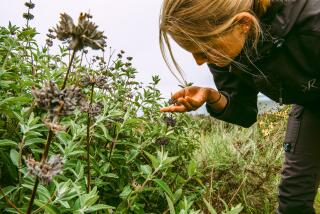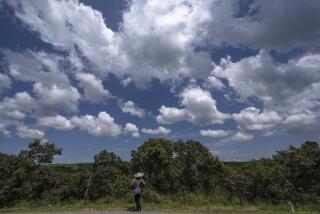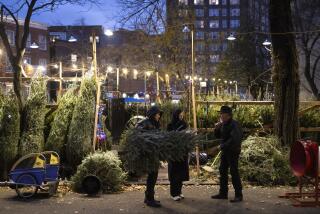Group in India Planting Trees, Johnny Appleseed-Style, for Food, Fuel
NEW DELHI — Holy men in their traditional saffron robes will hand over 4 million guava saplings and papaya seeds to Hindu pilgrims at an upcoming religious fair in a unusual effort to get people to plant trees as a way of saving their land and improving their livelihood.
The idea is that of an American volunteer group called Trees for Life in Wichita, Kan.
“It is something very new, very challenging,” said Deepak Nirula, the Indian representative of the organization, which aims to plant 5 million tress in poor countries to provide food and fuel for needy people.
The group is headed in Wichita by Balbir Mathur, who was born in India but is now a naturalized American. Mathur hopes to raise $15 million in small contributions to finance the effort.
Religious Fair
The organization is hiring Indian holy men and volunteers to distribute the saplings and seeds at Kumbh Mela, a three-week fair to be held in Allahabad in central India early next year. The religious fair, held every 12 years, attracts more than 10 million Hindu pilgrims who bathe in the holy Ganges River during a particularly auspicious configuration of the planets, the sun and the moon.
“We figured out that if we can give it a holy touch to the tree plantation drive, it can work,” Nirula said.
“The saplings and seeds will be part of the holy offering which no Hindu ignores, so we hope when they go back to their respective villages they will plant the saplings and the seeds,” said Nirula.
“We may be accused of exploiting the religious sentiments of the people, but it is for a good cause.”
Rapid Deforestation
Trees for Life is one of 175 organizations in India trying to save the forests that are being rapidly depleted. Each year, the country loses a total of 3.7 million acres.
“It is a very serious problem,” said Joyce Shankaran, a director at the National Wastelands Development Board, the official body that oversees the work of the volunteer organizations.
It is estimated that at the current rate of deforestation, India will lose nearly 10 million acres of woodlands--an area equal to the size of Switzerland--in the next five years.
Until a few years ago, the Indian government was operating under misleading statistics showing that 22% of the country’s 812-million-acre land mass was under forest cover. Ecologists say that the ideal forest cover should be 33% of the land mass, but 22% was considered acceptable in a nation of 800 million people.
From satellite photographs of India, however, the government now has determined that only about 10% of the land mass was under good forest cover.
Ecosystem Threatened
The entire Himalayan ecosystem is threatened as a consequence, with snow lines moving higher and perennial springs drying up because of lack of precipitation.
Vanishing forests also affect wildlife. Government reports say that some of the 350 species of mammals, 1,200 species of birds and 2,000 species of insects in India are threatened.
“Government alone can’t save the forest; it has gone beyond the control of any government,” said Akhil Chander, a volunteer working in New Delhi.
“There has to be a massive people’s movement including individuals, voluntary organizations, schools and private and public institution,” Chander said.
The Trees for Life group is working in five Indian states. The most visible project is in Allahabad where the group is planting papaya saplings.
200,000 Papaya Trees
“Our aim is 700,000 papaya tress in Allahabad; we have already planted 200,000,” Nirula said. The group wants to plant 2.7 million trees and set up 800 beehives in India by the end of 1989.
“This will mean an extra 13.5 million tons of fruit, fuel and fodder; 88,000 pounds of honey, and save 5,000 tons of wood from being used as fuel for cooking,” Nirula said.
The need for firewood and fodder, or coarse food for cattle, in India is about 133 million tons a year, but only 36 million tons are available in state-run stores. The rest comes from illegal felling of trees, government investigations indicate.
The Trees for Life group spends about $3 for planting a fruit tree.
“Our message is very clear and loud,” Nirula said. “Plant fruit trees and you will not go hungry.
“A $3 apple tree produces 10,000 pounds of apple in its lifetime . . . Can you imagine going to your grocer and asking him to give you 10,000 pounds of fruit for $3?
More to Read
Sign up for Essential California
The most important California stories and recommendations in your inbox every morning.
You may occasionally receive promotional content from the Los Angeles Times.










